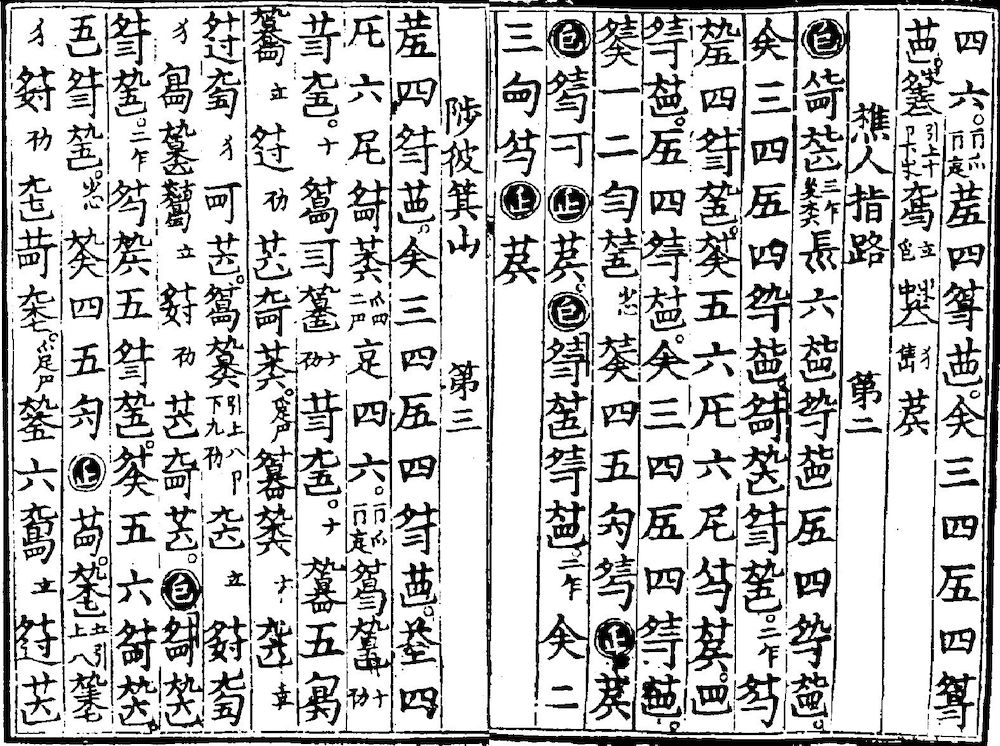Nov 16, 2013 © Ulrich Theobald
Shenqi mipu 神奇秘譜 "Miraculous secret scores for the zither" is a collection of musical scores for the small zither (qin 琴) compiled during the Ming period 明 (1368-1644) by Zhu Quan 朱權 (1378-1448), style Quxian 臞仙, Hanxuzi 涵虛子 or Danqiu Xiansheng 丹丘先生, the seventeenth son of Emperor Taizu 明太祖 (r. 1368-1398) and Prince of Daning 大寧, later of Nanchang 南昌, and therefore posthumously called Prince Xian of Ning 寧獻王. He had a conflict with the Yongle Emperor 永樂 (r. 1402-1424) about the imperial succession and was therefore not allowed to inherit the princedom of his father. He has also written two introductions to music, Qin ruan qimeng 琴阮啟蒙, and Taihe zhengyin pu 太和正音譜, as well as several theatre plays.
The 3-juan-long Shenqi mipu, finished in 1425, includes music composed by Zhu Quan himself (34 pieces) and by artists patronized by him, like Li Jizhi 李吉之, Jiang Yizhi 蔣怡之, Jiang Kangzhi 蔣康之, He Mianzhi 何勉之 and Xu Muzhi 徐穆之, as well as 16 ancient songs for the zither written during the Tang 唐 (618-907) and Song 宋 (960-1279) periods (Taigu shenpin 太古神品), like Guangling san 廣陵散, Gaoshan 高山, Liushui 流水, Yangchun 陽春, Jiukuang 酒狂 or Xiao hujia 小胡笳. These ancient songs are to be found in the first part of the book. They constitute the oldest surviving scores or tablatures of qin music. The book was finished and printed in 1425. It is significant for the history of Chinese music. However, it focuses on songs from the region of Zhejiang during the late Southern Song period 南宋 (1127-1279) like Xiaoxiang shuiyun 瀟湘水雲 or Qiaoge 樵歌. All melodies are accompanied by an introduction that explains the history of the tune and the text.
Figures 1. Tunes of the Shenqi mipu 神奇秘譜
 |
Tablature of the tunes Qiaoren zhilu 樵人指路 "The woodcutter shows the way" and Shibi qishan 陟彼箕山 "Ascending Mt. Jishan. The text of the tunes is not recorded, only the notes. |
The oldest surviving print dates from the Jiajing reign-period 嘉靖 (1522-1566), and a second one from the Wanli reign-period 萬曆 (1573-1619) that was published in Shanghai. The former version was reproduced in 1963 in the collection Qinqu jicheng 琴曲集成, the second one in the new edition of this collection, and also in a separate edition published by the Yinyue Chubanshe 音樂出版社 in 1955.
Sources:
Ai Pengfei 艾鵬飛. 2024. "Diaoyi chutan: Shenpin ruibin yi Shenqi mipu dapu houji 調意初探——《神品蕤賓意·神奇祕譜》打譜後記." Yueqi 樂器 2024 (2): 31-35.
Cheng Hongyuan 程鴻媛. 2022. "Guqin huangzhong diaoyi tanwei: Yi Shenqi mipu, Wugang qinpu wei li 古琴“黃鐘調意”探微——以《神奇祕譜》《梧岡琴譜》為例." Tianjin Yinyue Xueyuan xuebao 天津音樂學院學報 2022 (2): 98-106.
Fu Jingrui 傅景瑞. 1993. "Shenqi mipu 神奇秘譜." In Zhonghua baike yaolan 中華百科要覽, edited by Shi Quanchang 石泉長, 745. Liaoyang: Liaoning renmin chubanshe.
Jiaoyu da cidian bianzuan weiyuanhui 教育大辭典編纂委員會, ed. 1991. Jiaoyu da cidian 教育大辭典, part 8, Zhongguo gudai jiaoyu shi 中國古代教育史, vol. 1, 265. Shanghai: Shanghai jiaoyu chubanshe.
Li Fengyun 李鳳雲. 2000. "Shenqi mipu ji qi diaoyi qiantan 《神奇祕譜》及其調意淺探." Yinyue tansuo (Sichuan Yinyue Xueyuan xuebao) 音樂探索(四川音樂學院學報) 2000 (2): 9-13.
Lü Zhuang 呂壯. 2019. "Shenqi mipu banben kao 《神奇祕譜》版本考." Yinyue yanjiu 音樂研究 2019 (6): 33-43.
Qiu Tong 邱桐. 2025. "Mingai zao, zhongqi qinpu diaoyu zhifa lishi: Yi Shenqi mipu, Fengxuan xuanpin, Wugang qinpu zheng, yu diaoyi wei li 明代早、中期琴譜“調意”指法例釋——以《神奇祕譜》《風宣玄品》《梧岡琴譜》“徵”“羽”調意為例." Tianjin Yinyue Xueyuan xuebao 天津音樂學院學報 2025 (1): 81-88.
Qiu Tong 邱桐, Wang Shangying 王尚影, and Zhou Tianheng 周天姮. 2024. "Shilin guangji, Shenqi mipu, Wugang qinpu, Fengxuan xuanpin si pu wu yindiao diaoyi gaishu 《事林廣記》《神奇祕譜》《梧岡琴譜》《風宣玄品》四譜五音調調意概述." Huanghe zhi sheng 黃河之聲 2024 (18): 40-44.
Shi Xuanyuan 施宣圓, et al., eds. 1987. Zhongguo wenhua cidian 中國文化辭典, 974. Shanghai: Shanghai shehui kexue yuan chubanshe.
Wu Feng 吳楓, ed. 1987. Jianming Zhongguo guji cidian 簡明中國古籍辭典, 679. Changchun: Jilin wenshi chubanshe.
Wu Zhao 吳釗. 1989. "Shenqi mipu 神奇秘譜." In Zhongguo da baike quanshu 中國大百科全書, part Yinyue wudao 音樂•舞蹈, 577. Beijing and Shanghai: Zhongguo da baike quanshu chubanshe.
Yang Yanxing 楊雁行. 1997. "Zhu Quan de Shenqi mipu 朱權的《神奇秘譜》." In Zhonghua guocui da cidian 中華國粹大辭典, edited by Men Kui 門巋, and Zhang Yanjin 張燕瑾, 851. Beijing: Guoji wenhua chuban gongsi.
Yu Hui 喻輝. 1994a. "Shenqi mipu qinqu de quyin fangshi yu yinjie leixing 《神奇祕譜》琴曲的取音方式與音階類型." Huangzhong (Wuhan Yinxue Xueyuan xuebao) 黃鐘(武漢音樂學院學報) 1994 (2): 21-28.
Yu Hui 喻輝. 1994b. "Shenqi mipu qinqu de diaoxian fa 《神奇祕譜》琴曲的調弦法." Huangzhong (Wuhan Yinxue Xueyuan xuebao) 黃鐘(武漢音樂學院學報) 1994 (1): 16-22.
Zhang Cen 章岑, and Yi Xianling 易先玲. 2017. "Shenqi mipu qinqu daxiao biaoti, jieti yu qi biaoxian neirong zhi guanxi yanjiu 《神奇祕譜》琴曲大小標題、解題與其表現內容之關係研究." Yishu pingjian 藝術評鑑 2017 (23): 7-9.
